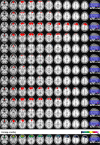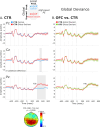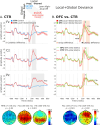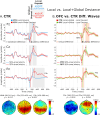Altered hierarchical auditory predictive processing after lesions to the orbitofrontal cortex
- PMID: 38334469
- PMCID: PMC10876214
- DOI: 10.7554/eLife.86386
Altered hierarchical auditory predictive processing after lesions to the orbitofrontal cortex
Abstract
Orbitofrontal cortex (OFC) is classically linked to inhibitory control, emotion regulation, and reward processing. Recent perspectives propose that the OFC also generates predictions about perceptual events, actions, and their outcomes. We tested the role of the OFC in detecting violations of prediction at two levels of abstraction (i.e., hierarchical predictive processing) by studying the event-related potentials (ERPs) of patients with focal OFC lesions (n = 12) and healthy controls (n = 14) while they detected deviant sequences of tones in a local-global paradigm. The structural regularities of the tones were controlled at two hierarchical levels by rules defined at a local (i.e., between tones within sequences) and at a global (i.e., between sequences) level. In OFC patients, ERPs elicited by standard tones were unaffected at both local and global levels compared to controls. However, patients showed an attenuated mismatch negativity (MMN) and P3a to local prediction violation, as well as a diminished MMN followed by a delayed P3a to the combined local and global level prediction violation. The subsequent P3b component to conditions involving violations of prediction at the level of global rules was preserved in the OFC group. Comparable effects were absent in patients with lesions restricted to the lateral PFC, which lends a degree of anatomical specificity to the altered predictive processing resulting from OFC lesion. Overall, the altered magnitudes and time courses of MMN/P3a responses after lesions to the OFC indicate that the neural correlates of detection of auditory regularity violation are impacted at two hierarchical levels of rule abstraction.
Keywords: EEG; attention; auditory perception; brain damage; human; meningioma; neuroscience; prediction.
© 2024, Asko et al.
Conflict of interest statement
OA, AB, SL, MF, AL, IF, TM, RK, TE, AS No competing interests declared
Figures














Update of
- doi: 10.1101/2023.01.04.521570
References
MeSH terms
Grants and funding
LinkOut - more resources
Full Text Sources
Miscellaneous

